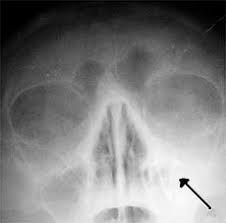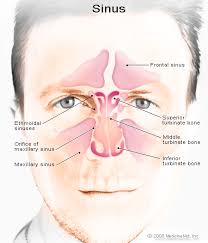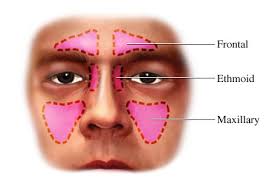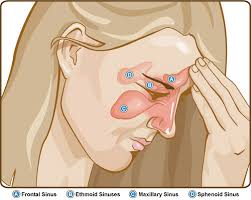Sinusitis:- refers to inflammation of the sinuses that occurs with a viral, bacterial, or fungal infection






Causes, and risk factors:-
The sinuses are air-filled spaces in the skull (behind the forehead, nasal bones, cheeks, and eyes) that are lined with mucus membranes. Healthy sinuses contain no bacteria or other germs. Usually, mucus is able to drain out and air is able to circulate.
When the sinus openings become blocked or too much mucus builds up, bacteria and other germs can grow more easily.
Sinusitis can occur from one of these conditions:
Small hairs (cilia) in the sinuses, which help move mucus out, do not work properly due to some medical conditions.
Colds and allergies may cause too much mucus to be made or block the opening of the sinuses.
A deviated nasal septum, nasal bone spur, or nasal polyps may block the opening of the sinuses.
Sinusitis can be:
Acute -- symptoms last up to 4 weeks
Sub-acute -- symptoms last 4 - 12 weeks
Chronic -- symptoms last 3 months or longer
Acute sinusitis is usually caused by a bacterial infection in the sinuses that results from an upper respiratory tract infection. Chronic sinusitis refers to long-term swelling and inflammation of the sinuses that may be caused by bacteria or a fungus.
The following may increase your risk or your child's risk of developing sinusitis:
Allergic rhinitis or hay fever
Cystic fibrosis
Day care
Diseases that prevent the cilia from working properly, such as Kartagener syndrome and immotile cilia syndrome.
Changes in altitude (flying or scuba diving)
Large adenoids
Smoking
Tooth infections (rare)
Weakened immune system from HIV or chemotherapy
Signs and symptoms:-
Headache/facial pain or pressure of a dull, constant, or aching sort over the affected sinuses is common with both acute and chronic stages of sinusitis. This pain is typically localized to the involved sinus and may worsen when the affected person bends over or when lying down. Pain often starts on one side of the head and progresses to both sides.
Acute and chronic sinusitis may be accompanied by thick nasal discharge that is usually green in color and may contain pus (purulent) and/or blood. Often a localized headache or toothache is present, and it is these symptoms that distinguish a sinus-related headache from other types of headaches, such as tension and migraine headaches. Infection of the eye socket is possible, which may result in the loss of sight and is accompanied by fever and severe illness. Another possible complication is the infection of the bones (osteomyelitis) of the forehead and other facial bones – Pott's puffy tumor.
Sinus infections can also cause inner ear problems due to the congestion of the nasal passages. This can be demonstrated by dizziness, "a pressurized or heavy head", or vibrating sensations in the head.
Recent studies suggest that up to 90% of "sinus headaches" are actually migraines.[verification needed] The confusion occurs in part because migraine involves activation of the trigeminal nerves, which innervate both the sinus region and the meninges surrounding the brain.
As a result, it is difficult to accurately determine the site from which the pain originates. Additionally, nasal congestion can be a common result of migraine headaches, due to the autonomic nerve stimulation that can also cause in tearing (lacrimation) and a runny nose (rhinorrhea).[citation needed] A study found that patients with "sinus headaches" responded to triptan migraine medications, but stated dissatisfaction with their treatment when they are treated with decongestants or antibiotics. People with migraines do not typically have the thick nasal discharge that is a common symptom of a sinus infection.
Causes, and risk factors:-
The sinuses are air-filled spaces in the skull (behind the forehead, nasal bones, cheeks, and eyes) that are lined with mucus membranes. Healthy sinuses contain no bacteria or other germs. Usually, mucus is able to drain out and air is able to circulate.
When the sinus openings become blocked or too much mucus builds up, bacteria and other germs can grow more easily.
Sinusitis can occur from one of these conditions:
Small hairs (cilia) in the sinuses, which help move mucus out, do not work properly due to some medical conditions.
Colds and allergies may cause too much mucus to be made or block the opening of the sinuses.
A deviated nasal septum, nasal bone spur, or nasal polyps may block the opening of the sinuses.
Sinusitis can be:
Acute -- symptoms last up to 4 weeks
Sub-acute -- symptoms last 4 - 12 weeks
Chronic -- symptoms last 3 months or longer
Acute sinusitis is usually caused by a bacterial infection in the sinuses that results from an upper respiratory tract infection. Chronic sinusitis refers to long-term swelling and inflammation of the sinuses that may be caused by bacteria or a fungus.
The following may increase your risk or your child's risk of developing sinusitis:
Allergic rhinitis or hay fever
Cystic fibrosis
Day care
Diseases that prevent the cilia from working properly, such as Kartagener syndrome and immotile cilia syndrome.
Changes in altitude (flying or scuba diving)
Large adenoids
Smoking
Tooth infections (rare)
Weakened immune system from HIV or chemotherapy
Signs and symptoms:-
Headache/facial pain or pressure of a dull, constant, or aching sort over the affected sinuses is common with both acute and chronic stages of sinusitis. This pain is typically localized to the involved sinus and may worsen when the affected person bends over or when lying down. Pain often starts on one side of the head and progresses to both sides.
Acute and chronic sinusitis may be accompanied by thick nasal discharge that is usually green in color and may contain pus (purulent) and/or blood. Often a localized headache or toothache is present, and it is these symptoms that distinguish a sinus-related headache from other types of headaches, such as tension and migraine headaches. Infection of the eye socket is possible, which may result in the loss of sight and is accompanied by fever and severe illness. Another possible complication is the infection of the bones (osteomyelitis) of the forehead and other facial bones – Pott's puffy tumor.
Sinus infections can also cause inner ear problems due to the congestion of the nasal passages. This can be demonstrated by dizziness, "a pressurized or heavy head", or vibrating sensations in the head.
Recent studies suggest that up to 90% of "sinus headaches" are actually migraines.[verification needed] The confusion occurs in part because migraine involves activation of the trigeminal nerves, which innervate both the sinus region and the meninges surrounding the brain.
As a result, it is difficult to accurately determine the site from which the pain originates. Additionally, nasal congestion can be a common result of migraine headaches, due to the autonomic nerve stimulation that can also cause in tearing (lacrimation) and a runny nose (rhinorrhea).[citation needed] A study found that patients with "sinus headaches" responded to triptan migraine medications, but stated dissatisfaction with their treatment when they are treated with decongestants or antibiotics. People with migraines do not typically have the thick nasal discharge that is a common symptom of a sinus infection.
Homeopathic Treatment:-
BELLADONNA: Throbbing pains in the front part of the head that come on suddenly and tend to leave suddenly only to return are characteristic of children who need this medicine. (see Headache)
HEPAR SULPHUR: Rarely indicated at the beginning of a sinusitis condition, Hepar sulphur children begin sneezing and then develop sinusitis from the least exposure to cold air. Their nasal discharge is thick and yellow. The nostrils become very sore from the acrid discharge, and their nasal passages become sensitive to cold air. Concurrently, they may have a headache with a sense of a nail or a plug that is thrust into the head along with a boring or bursting pain. Their headache above the nose is worse from shaking the head, motion, riding in a car, stooping, moving the eyes, or simply from the weight of a hat, but is relieved by the firm pressure of a tight bandage. The scalp is so sensitive that simply combing the hair may be painful.
KALI BIC: The distinguishing feature of children with sinusitis who need this medicine is that they have a thick, stringy nasal discharge. They have extreme pain at the root of the nose that is better by applying pressure there. The bones and scalp feel sore. Dizziness and nausea when rising from sitting and the severe pain may lead to dimmed vision. The pains are worse by cold, light, noise, walking, stooping, and in the morning (especially on waking or at 9 am) or at night. They prefer to lie down in a darkened room and feel better by warmth, warm drinks, or overeating.
Mercurius: These children feel as though their head was in a vise. The pains are worse in open air, from sleeping, and after eating and drinking. The pains are also aggravated by extremes of hot and cold temperature. The scalp and the nose become very sensitive to the touch. Their teeth feel long and painful, and they may salivate excessively. The nasal discharge is usually green and too thick to run. It is offensive smelling and acrid.
PULSATILLA: The head pain is worse when lying down and in a warm room and is better in cool air for children who need this medicine. The sinusitis may begin after being overheated. Stooping, sitting, rising from lying down, and eating can aggravate the head pain, which is often in the front part of the head and accompanied with digestive problems. They get some relief from slow walking in the open air or by wrapping the head tightly in a bandage. This condition is commonly experienced when the child is in school. The nasal discharge is often thick and yellow or green.
Silicea: These children usually have a chronically stuffed nose. They have a sense as though their head would burst. The head pain tends to be worse in one eye, usually the right. It is aggravated by mental exertion (students tend to get sinusitis while studying for an exam). Cold air, moving the head, light or noise can also aggravate the head pain. It is relieved by wrapping the head warmly and tightly or by applying heat.
Spigella: Children who develop sinusitis with a sharp pain that is worse on the left side may need this medicine. They tend to get sinusitis after exposure to cold or cold, wet weather. They feel pain from warmth or when they stoop or bend the head forward, and they feel some relief by cold applications or from washing with cold water.

 19:58
19:58
 Dr. Ajay Srivastava
Dr. Ajay Srivastava
 Posted in
Posted in 
No Response to "Sinusitis ?? homeopathic treatment"
Post a Comment